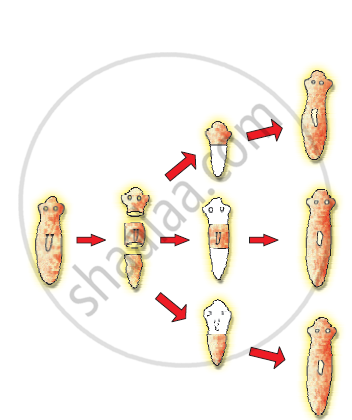Advertisements
Advertisements
प्रश्न
On cutting the body of an organism into many pieces it was observed that many of these pieces developed as new individuals. Name the process and list two organisms in which this process may be observed. Draw a schematic diagram to illustrate the changes that are likely to be observed during the development of new individuals in any one of the organisms named.
उत्तर
The process is referred to as regeneration. Example: Planaria, Hydra etc.
Regeneration in Planaria:

APPEARS IN
संबंधित प्रश्न
Identify the figures showing the process of budding in yeast.

(A) I, II and III
(B) II, III and IV
(C) I, II and IV
(D) III, IV and I
The factors responsible for the rapid spreading of bread mould on slices of bread are :
(i) presence of large number of spores in air
(ii) presence of large number of thread-like branched hyphae
(iii) presence of moisture and nutrients
(iv) formation of round shaped sporangia
(a) (i) and (iii)
(b) (ii) and (iv)
(c) (i) and (ii)
(d) (iii) and (iv)
Mention the common method of reproduction in Ferns.
Mention the common method of reproduction in Mango.
Choose the correct statement(s) on budding in yeast from the following :
I. A parent cell divides into two or more daughter cells and here the parent identity is lost.
II. In this the elongated nucleus divides to form two or more daughter nuclei.
III. A bud arises from a particular region on a parent body.
IV. After detaching from the parent body the bud grows into a new independent individual.
(A) I only
(B) III only
(C) II and III only
(D) III and IV only
After observing the prepared slides of binary fission in Amoeba and budding in yeast following observations were reported:
(a) Single cells of Amoeba and yeast were undergoing binary fission and budding respectively.
(B) Cytokinesis was observed in the yeast cell.
(C) Elongated nucleus was dividing to form two daughter nuclei in Amoeba.
(D) A chain of buds were observed due to reproduction in Amoeba.
The correct observation(s) is/are:
(A) a and c
(B) b only
(C) c and d
(D) d, a and c
A student was given two permanent slides, one of binary fission in Amoeba and other of budding in yeast. He was asked to identify any one difference in the nucleus of the two. One such difference, he identified correctly was
(1) Presence of one nucleus in Amoeba, two in yeast cell and one in bud.
(2) Presence of two nuclei in centrally constricted Amoeba, one in yeast cell and one in its bud.
(3) Presence of two distant nuclei in Amoeba, one in yeast cell and two in bud.
(4) Presence of a single nucleus each in Amoeba, yeast cell and its attached bud.
Write four lines on the following: Grafting
Yeast reproduces asexually by means of multiple fission.
Which of the following methods of asexual reproduction are observed in lower organisms?
